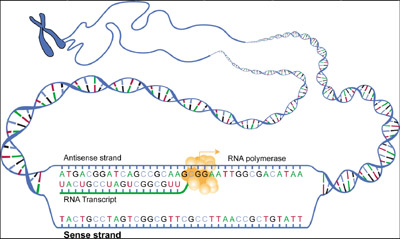. .
|
S
-
Sanger sequencing
- A widely used method of determining the order of bases in DNA.
See also:
sequencing, shotgun sequencing
-
Satellite
- A chromosomal segment that branches off from the rest of the chromosome but is still connected by a thin filament or stalk.
-
Scaffold
- In genomic mapping, a series of contigs that are in the right order but not necessarily connected in one continuous stretch of sequence.
-
Segregation
- The normal biological process whereby the two pieces of a chromosome pair are separated during meiosis and randomly distributed to the germ cells.
-
Sense Strand
- The DNA strand of a gene that is complementary in sequence
to the template (antisense) strand, and identical to the transcribed
mRNA sequence (except that DNA contains T where RNA has
U). Gene sequences found in databases are always of the
sense strand, in the 5' to 3' direction.

-
Sequence
-
See:
base sequence
-
Sequence assembly
- A process whereby the order of multiple sequenced DNA fragments is determined.
-
Sequence tagged site (STS)
- Short (200 to 500 base pairs) DNA sequence that has a single occurrence in the human genome and whose location and base sequence are known. Detectable by polymerase chain reaction, STSs are useful for localizing and orienting the mapping and sequence data reported from many different laboratories and serve as landmarks on the developing physical map of the human genome. Expressed sequence tags (ESTs) are STSs derived from cDNAs.
-
Sequencing
- Determination of the order of nucleotides (base sequences) in a DNA or RNA molecule or the order of amino acids in a protein.
-
Sequencing technology
- The instrumentation and procedures used to determine the order of nucleotides in DNA.
-
Sex chromosome
- The X or Y chromosome in human beings that determines the sex of an individual. Females have two X chromosomes in diploid cells; males have an X and a Y chromosome. The sex chromosomes comprise the 23rd chromosome pair in a karyotype.
See also:
autosome
-
Sex-linked
- Traits or diseases associated with the X or Y chromosome; generally seen in males.
See also:
gene, mutation, sex chromosome
-
Shotgun method
- Sequencing method that involves randomly sequenced cloned pieces of the genome, with no foreknowledge of where the piece originally came from. This can be contrasted with "directed" strategies, in which pieces of DNA from known chromosomal locations are sequenced. Because there are advantages to both strategies, researchers use both random (or shotgun) and directed strategies in combination to sequence the human genome.
See also:
library, genomic library
-
Single nucleotide polymorphism (SNP)
- DNA sequence variations that occur when a single nucleotide (A, T, C, or G) in the genome sequence is altered.
See also:
mutation, polymorphism, single-gene disorder
-
Single-gene disorder
- Hereditary disorder caused by a mutant allele of a single gene (e.g., Duchenne muscular dystrophy, retinoblastoma, sickle cell disease).
See also:
polygenic disorders
-
Somatic cell
- Any cell in the body except gametes and their precursors.
See also:
gamete
-
Somatic cell gene therapy
- Incorporating new genetic material into cells for therapeutic purposes. The new genetic material cannot be passed to offspring.
See also:
gene therapy
-
Somatic cell genetic mutation
- A change in the genetic structure that is neither inherited nor passed to offspring. Also called acquired mutations.
See also:
germ line genetic mutation
-
Southern blotting
- Transfer by absorption of DNA fragments separated in electrophoretic gels to membrane filters for detection of specific base sequences by radio-labeled complementary probes.
-
Spectral karyotype (SKY)
- A graphic of all an organism's chromosomes, each labeled with a different color. Useful for identifying chromosomal abnormalities.
See also:
chromosome
-
Splice site
- Location in the DNA sequence where RNA removes the noncoding areas to form a continuous gene transcript for translation into a protein.
-
Sporadic cancer
- Cancer that occurs randomly and is not inherited from parents. Caused by DNA changes in one cell that grows and divides, spreading throughout the body.
See also:
hereditary cancer
-
Stem cell
- Undifferentiated, primitive cells in the bone marrow that have the ability both to multiply and to differentiate into specific blood cells.
-
Structural genomics
- The effort to determine the 3D structures of large numbers of proteins using both experimental techniques and computer simulation
-
Substitution
- In genetics, a type of mutation due to replacement of one nucleotide in a DNA sequence by another nucleotide or replacement of one amino acid in a protein by another amino acid.
See also:
mutation
-
Suppressor gene
- A gene that can suppress the action of another gene.
-
Syndrome
- The group or recognizable pattern of symptoms or abnormalities that indicate a particular trait or disease.
-
Syngeneic
- Genetically identical members of the same species.
-
Synteny
- Genes occurring in the same order on chromosomes of different species.
See also:
linkage, conserved sequence
A
B
C
D
E
F
G
H
I
J
K
L
M
N
O
P
Q
R
S
T
U
V
W
X
Y
Z
|

|










 - Please bookmark this page (add it to your favorites).
- Please bookmark this page (add it to your favorites).